You may not find this terribly rewarding unless you're included here, so this is a good time for casual and random browsers to turn back before they get too caught up in the sweep and majesty of the proceedings and can't let go.
We're not based in Europe anymore, and we've struggled through the covid-19 lockdowns like everyone else, so we haven't set foot in Italy since February 2019. Now we're making up for lost time with mad sightseeing, but missing the cats even more sorely as the days fly by.
Ascoli Piceno, Day 2: The Pinacoteca Civica

It's our second full day in Ascoli Piceno, 18 November 2022, and therefore it's time for a visit to the picture gallery, and whatever other wonders they may have in there.

The Pinacoteca Civica is on the piano nobile, the fancier rooms one floor up.

Someone important must have arrived before us.

We're still on the ground floor of the Palazzo Comunale, hunting for the stairway up to find the good stuff.
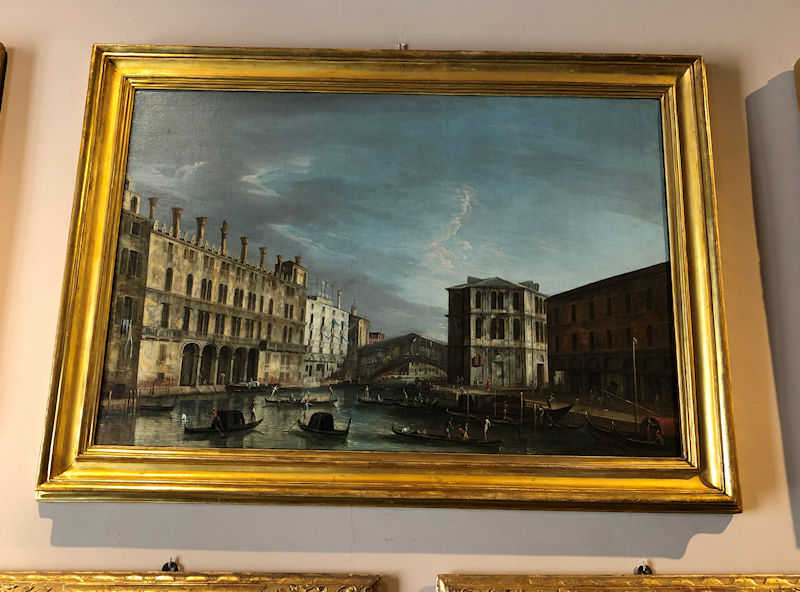
Looks like we're here. The city's art gallery was initiated in 1861, we learn, based on the transfer of works from 'the churches of the suppressed religious orders', then enriched by bequests and donations. It's also got a lot of works by local artists.

Beautiful in its own way, but functional? For bobby pins, paper clips, and AAA batteries? We're in the former Municipal Council Hall until the reorganization of 1988, now called the 'Ceci Room', named for a prominent donor, the local surgeon Antonio Ceci, and filled with 'a collection of Ceci furniture in layered ebony and inlaid with ivory (nineteenth century)'. Like this one apparently.
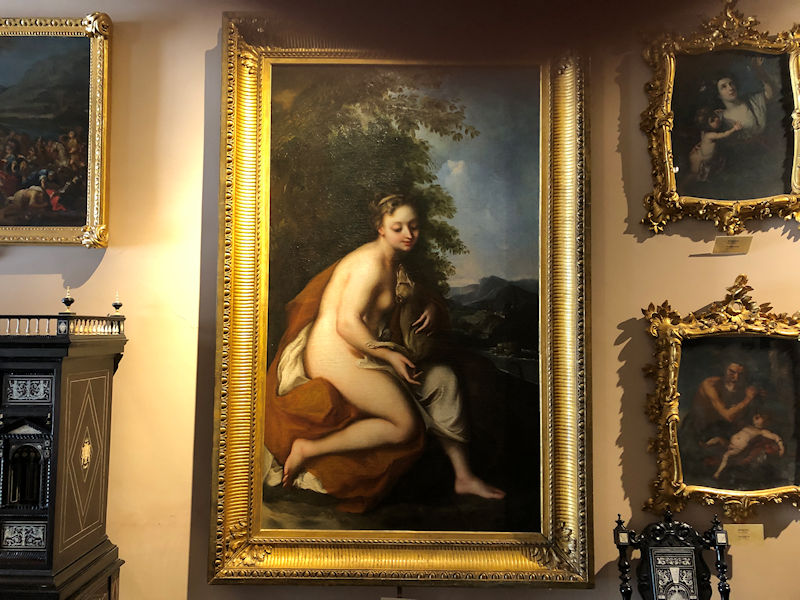
This is identified as 'Chastity' (La castità), the nearly naked sort of chastity apparently, by Il Parmigianino (not the original Il Parmigianino, 1503-1540; the other Il Parmigianino, 1666-1751). Could this have come from one of the 'suppressed religious orders'?

This is by the famous painter Arte Fiamminga, 16th century: 'The Holy family resting during the Flight to Egypt' ( by aka 'Flemish artist').
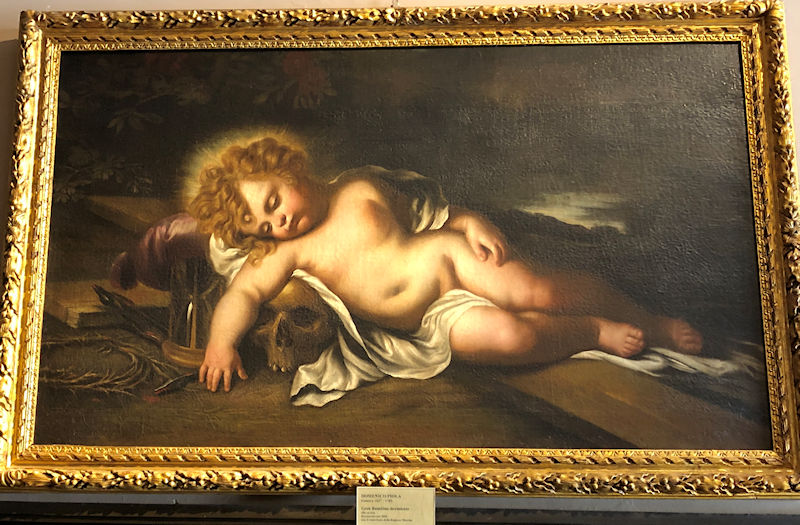
Cute little Jesus --' Gesù Bambino dormiente' -- by Domenico Piola (1627-1703), 'the leading artist in Genoa in the second half of the 17th century'

An interesting rustic landscape with an old mill, 'Paesaggio con mulino', by Cornelis Decker of Haarlem, 1618-1678, seemingly a specialist in dark landscapes.

A sermon by St Paul ('Predica di San Paulo'), by Giampaolo Pannini, 18th century, restored in 2003. One wonders if Paul chose the venue to emphasize that the pagan gods are all gone now.
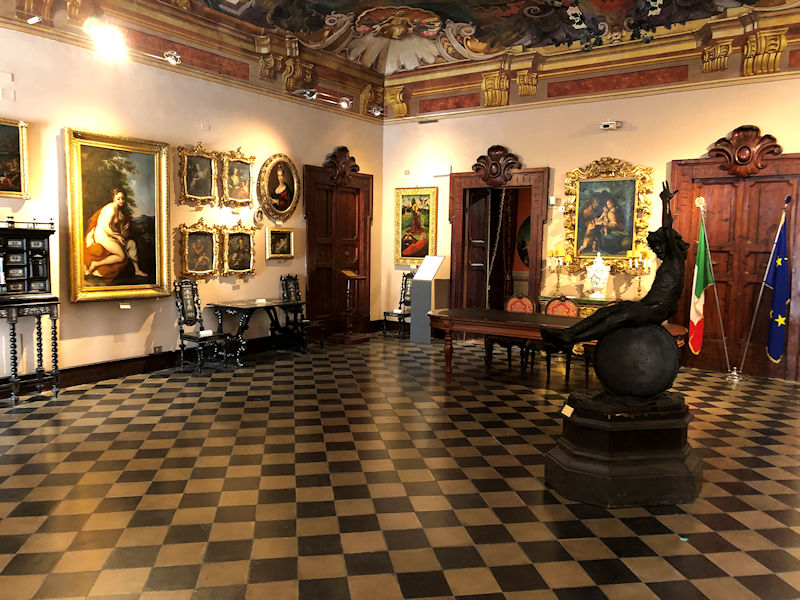
The Ceci Room

A 19th century base for something or other that's not there anymore

We're in the Hall of Victory now, named for Italy's 'victory' in World War One. It was the Elders' Council room in the 14th century, then a courtroom, then from the 16th century the community theatre until the Ventido Basso Theatre was built in 1846 (which we'll visit soon). The wooden choir seats along the walls were inherited from the Church of Sant'Antonio Abate.

Finally, some of the medieval good stuff. That's a triptych of the Madonna with Jesus, John the Baptist and St Peter, by Cola dell'Amatrice (1st half of the 16th century, aka Nicola Filotesio), one of Ascoli's two favorite early artists (along with the 15th century Carlo Crivelli). Wikipedia says that there was a museum dedicated to Cola's work in the Abruzzi town of Amatrice until it was destroyed in the Central Italy Earthquake of 2016 ('Amatrice is not here anymore, half of the town is destroyed').

Another by Cola dell'Amatrice, his first in Ascoli (1509), of the enthroned Madonna and baby with (probably) St Catherine of Alexandria, top right St Lucia with her eyes on a plate, St Bartholomew with the knife the bad guys flayed him with, and Mark writing in his book. It came from the church of St Bartholomew alle Piagge in Ascoli.
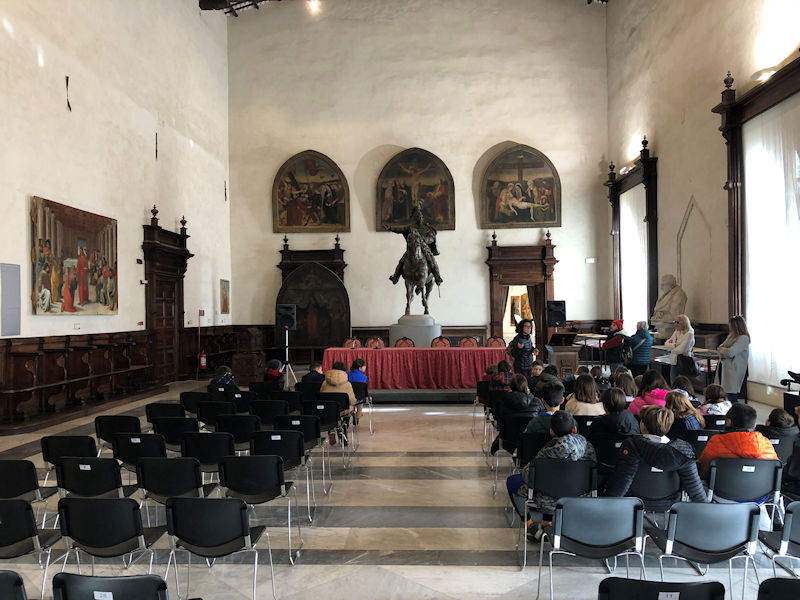
Another view of the Victory Room with a school class in session (we'll tiptoe past).
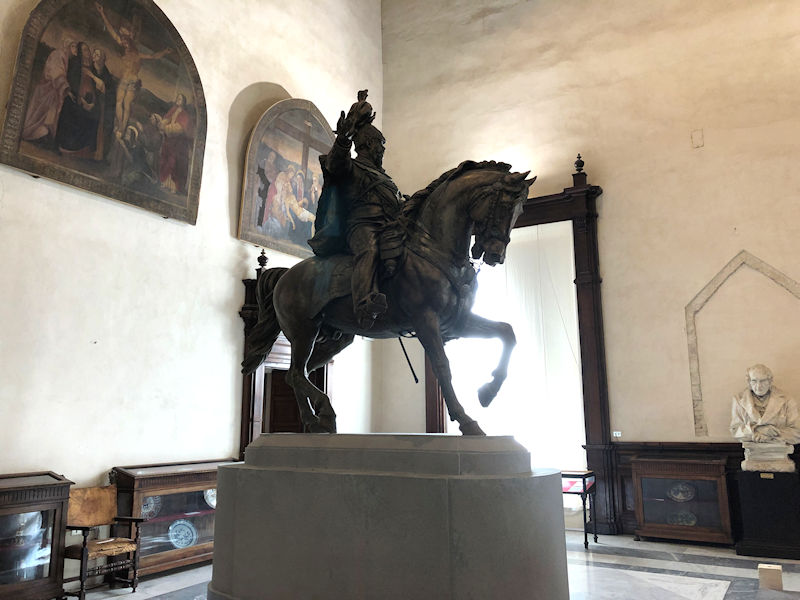
This is the equestrian statue of Victor Emanuel II that was made by Nicola Cantalamessa Papotti (1833-1910) of Ascoli, or rather the artist's plaster model of it, for the competition in 1889 for the Victor Emanuele equestrian thing to grace the Altare della Patria monument going up in the centre of Rome by the Forum (the Altare project was designed by Giuseppe Sacconi, also from Ascoli Piceno). Papotti's was rejected, alas, and the artist donated this model for the Ascoli city hall, and it's been pawing the ground here since 1902. (The statue winner was Enrico Chiaradia.)
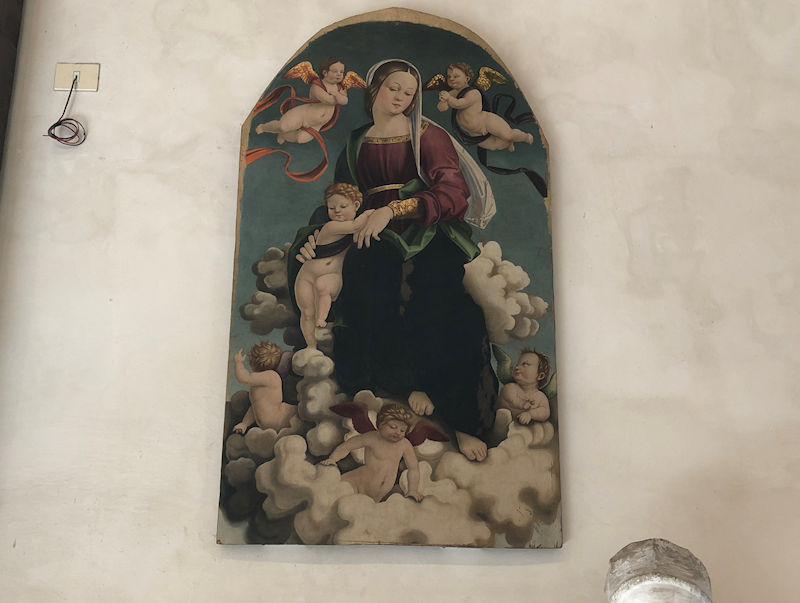
This is a panel of the Madonna and Child with a host of cute little kids with wings on, made by Vincenzo Pagani (c.1490-1568) who was originally from nearby Fermo, a magistrate who converted to painter, influenced by Carlo Crivelli, later working in Raphael's studio in Rome. He made the altarpiece of the Sant'Agostino church here in Ascoli.
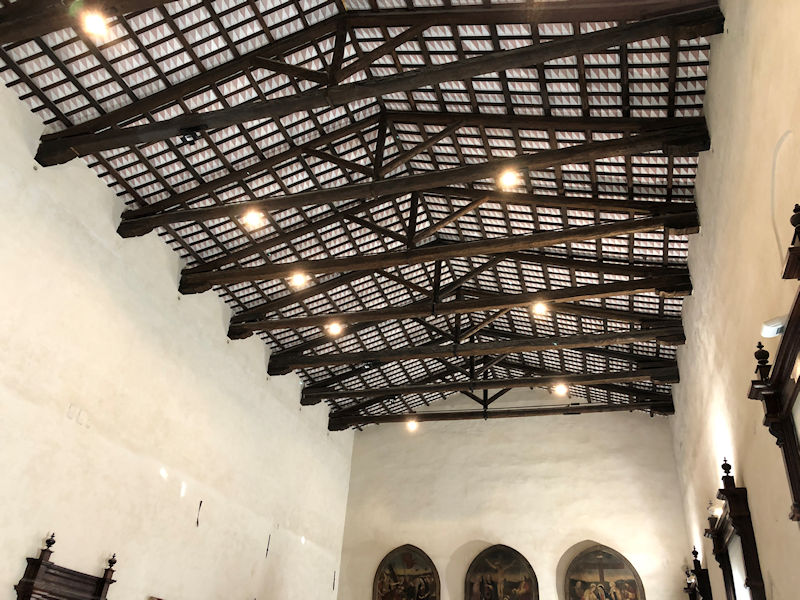
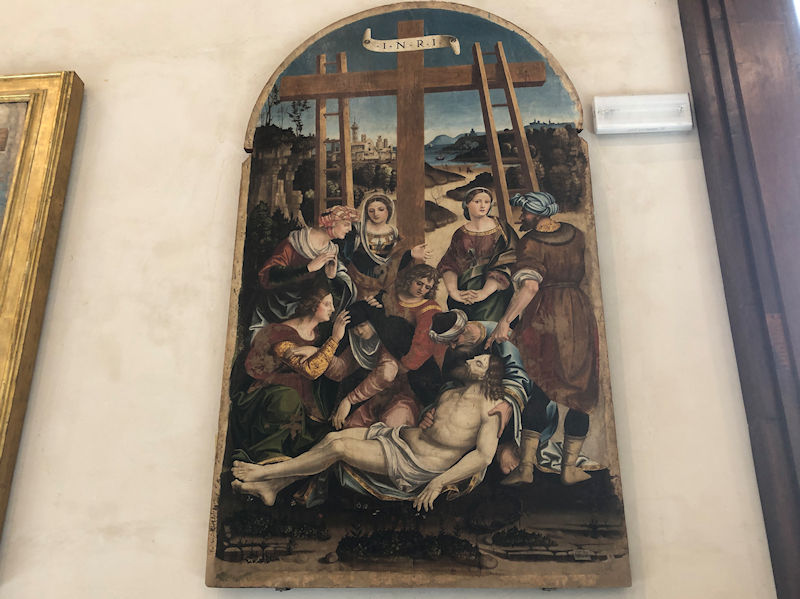
A Deposition, also by Pagani and dated 1529, from the Chiesa di S. Pietro in Castello here in Ascoli

Here's a grim piece, also a tempera on panel, of the 'Mourning', attributed to the 'Venetian School' in the first part of the 15th century.
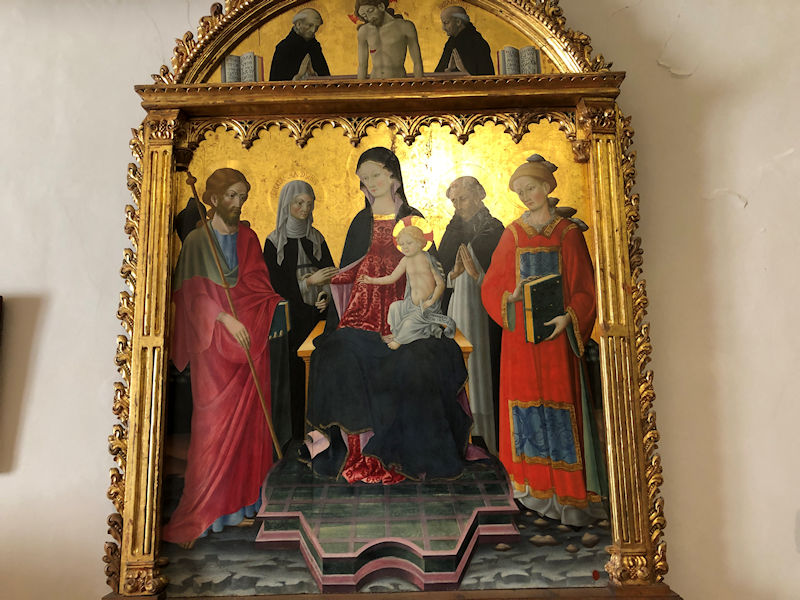
The 'Mystical Marriage of St Catherine' of Siena (in her Dominican suit; Catherine of Alexandria carries around her torture wheel), John the Baptist on the left; the chap with the rocks on his head is St Stephen, who got himself stoned. Attributed to Paolo da Visso, active 1431-1482.

Terracotta art from the Abruzzo region, prob. late 15th century
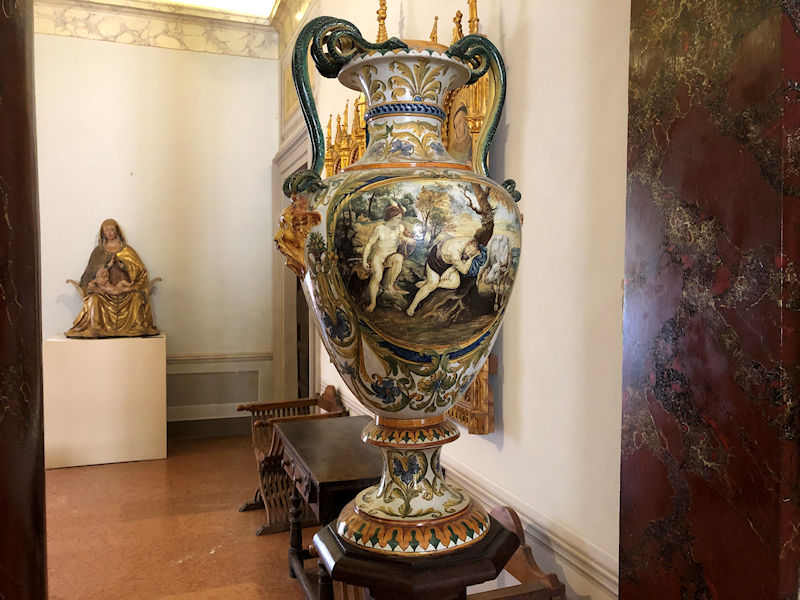
Very ornate! Maybe not very useful for anything. Flowers maybe?

Scenes from the Life . . .
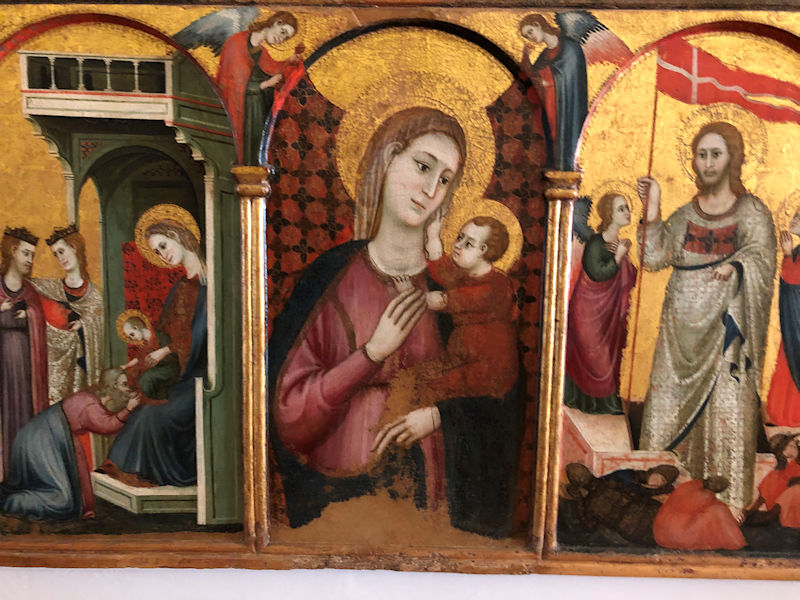
. . . the same, a little zoomed
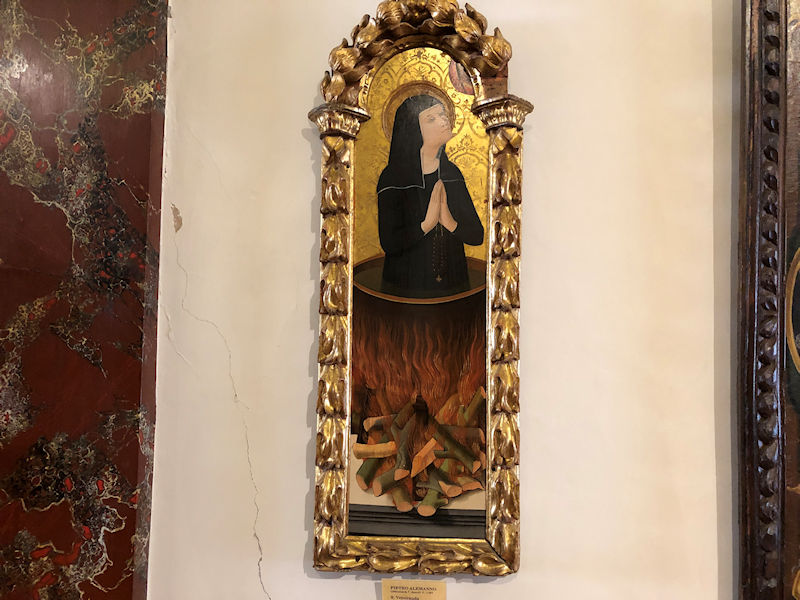
That's St Venera or Veneranda (traditionally AD 100-143), a little-known martyr who was said to have roamed all over Sicily and southern Italy making an infinitude of converts despite official torture sessions (including being boiled in oil, as here, which bothered her not at all, so her torturer converted, too), and vanquishing a dragon, until eventually she was decapitated in Gaul, reciting a prayer whilst dying that made a temple to Apollo collapse.
According to Wikipedia, 'after her martyrdom in Gaul, Christians are said to have transported her body to Ascoli Piceno, where it was venerated until the 4th century', when somebody nicked it and took it to Rome.
Pietro Alemanno, an immigrant Austrian (thus the 'surname'), was another great favorite in Ascoli Piceno, who trained under Carlo Crivelli and was active in Ascoli from 1475 until his death here in 1498.

Another 15th century 'Abruzzi Art' piece, in polychrome and gilded wood, of the 'Transito della Vergine'
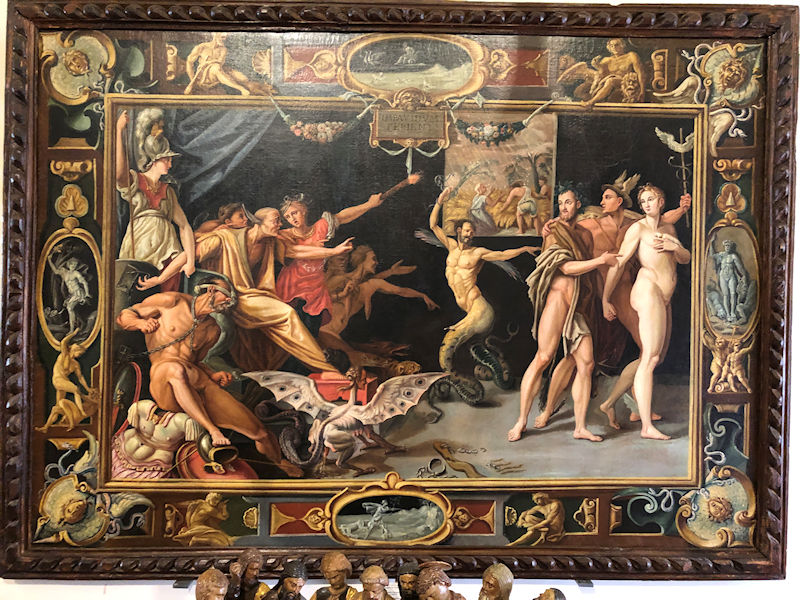
The 'Allegory of Calumny' (ooof!), by Federico Zuccari (& workshop) who was active in the 2nd half of the 16th century, all over Rome, Tuscany, Venice, the Escorial in Spain, and even in England in 1574, where he made portraits of Queen Elizabeth, Leicester, Mary Queen of Scots, Walsingham, Admiral Howard, & the Lord Keeper Sir Nicholas Bacon. He died in Ancona in 1609.
A picture of his called the 'Allegory of Calumny', based on a classical work, included satirical representations of some of his enemies at the court in Rome, which got him temporarily exiled from the city. That's presumably this picture, which was donated to the gallery in 2013.

Another Pietro Alemanno, the 'Madonna Enthroned with Bambino' and a bunch of sorry looking saints, presumably St Nicholas with crozier & three balls, an uncharactistically ugly Mary Magdalene with her ointment jar and flowing golden hair, John the Baptist with his 'Ecce Agnus Dei', and St Leonard with his manacles. And a Baby Jesus with a precocious blessing.

A rather unprepossessing Baby Jesus with Mom, Sebastian with his arrows, Catherine of Alexandria with her torture wheel. Judging by the hairlines, that could be another Pietro Alemanno.

A much more attractive 'Madonna and Bambino', by Ludovico Lana (c1597-1646) of Modena

The Gallery, with more works from the collection of the Ascolano surgeon Antonio Ceci
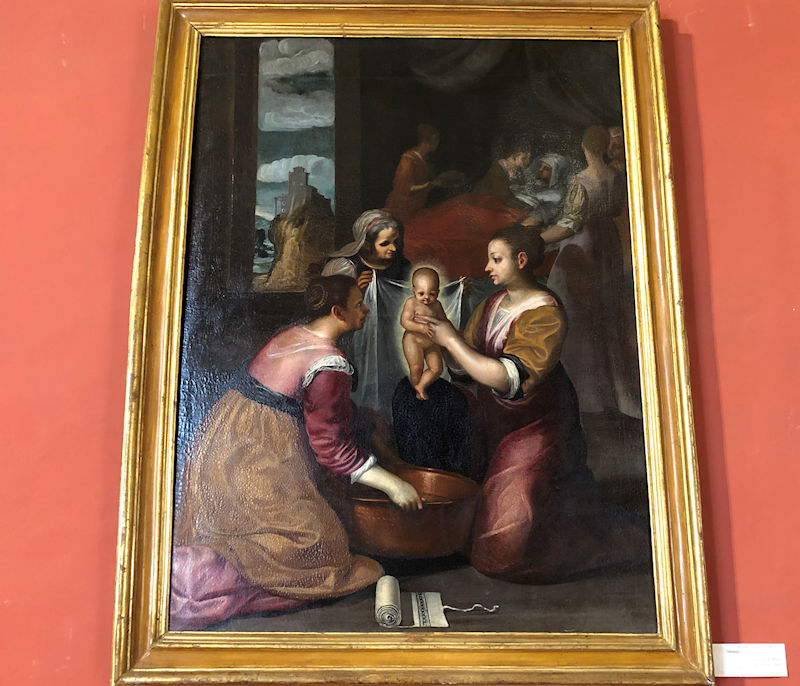
One of my favorites here -- that ugly baby is not actually Baby Jesus: this is the 'Birth of the Virgin Maria', by Carlo Allegretti, who's dated as '16th-17th century'. He was trained by Giacomo Bassano in Venice but worked in various places in Ascoli Province, including in a few churches here in Ascoli Piceno.

Now we're getting to some of the better known guys -- in this case, the Neapolitican Luca Giordano, the 'Transito di san Giuseppe con san Michele arcangelo', late 17th century.

And this, photographed from around a big piece of furniture, is an Annunciation from about 1628 by Guido Reni.
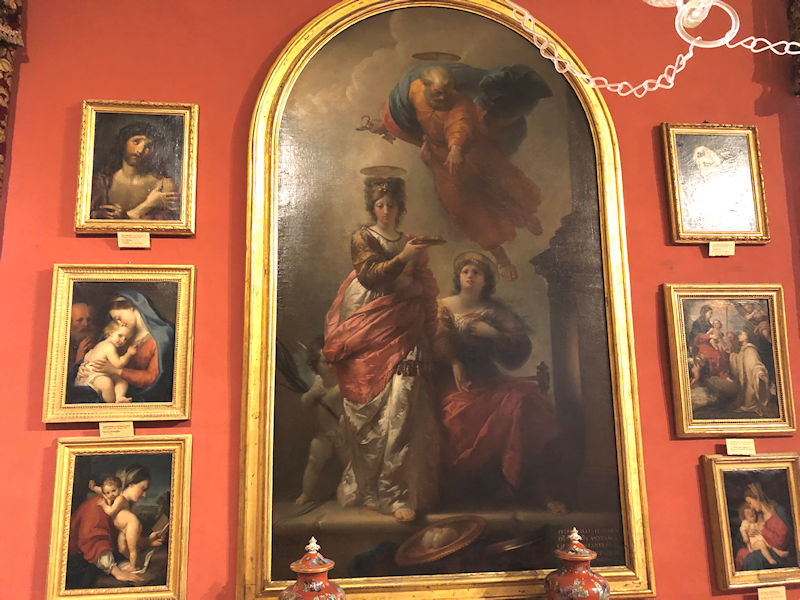
This is a rather odd tableau by Giuseppe Cades, dated to 1781, purporting to show 'St Peter appearing to St Lucia and St Agatha'. 'Appearing to' doesn't really seem to explain what he's up to here. According to the label, this was restored in 1999 by the Philadelphia Museum of Art. The saintly ladies are seen with the dinner plates bearing their iconographic symbols.

Very cute kid, and Mom trying read her book, by Antonio Cavallucci, 1752-1795

An intriguing bronze, The Pupils of the 'Heart', by Ettore Ximenes (1855-1926), the sculptor who made the excellent but frightening statue of Dante Alighieri in the Meridian Hill Park in Washington, D.C., which was gifted to the park by a New York guy on behalf of Italian-born Americans and accepted by Act of Congress in 1922.

A great picture, called 'He loves me, he loves me not' (m'ama o non m'ama), by Nazzareno Orlandi, who was born in Ascoli Piceno in 1861 but spent most of his life in Buenos Aires, dying in 1952.


Viewed from any angle, walking all about it, it's not easy to discern what's going on here. It's not by Donatello, Bernini, or Canova.

This is a very fun picture gallery. Probably better to admire it during a visit than having to live here.
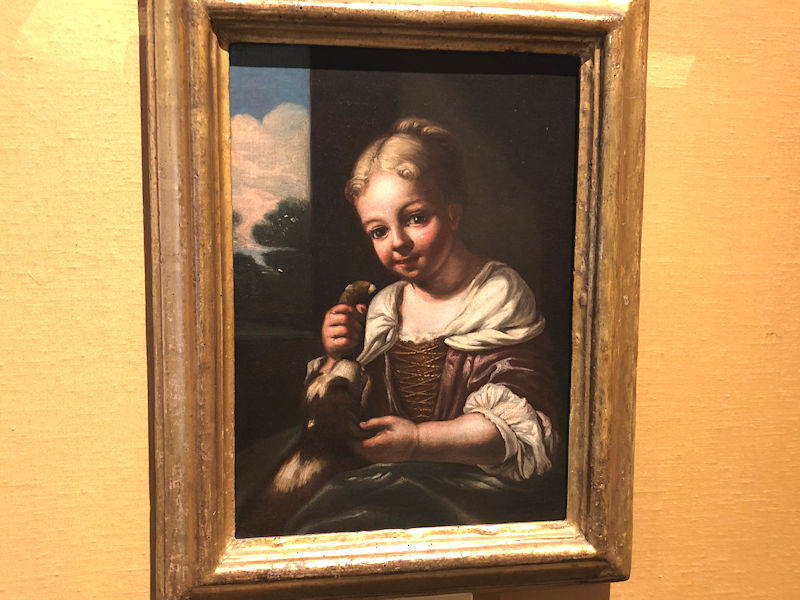
'Girl with Hamster and Dog', by Antonio Amorosi (1660-1738), purchased in 2003 with financing from the Marche Region. Amorosi was active in Acoli Piceno and Rome.
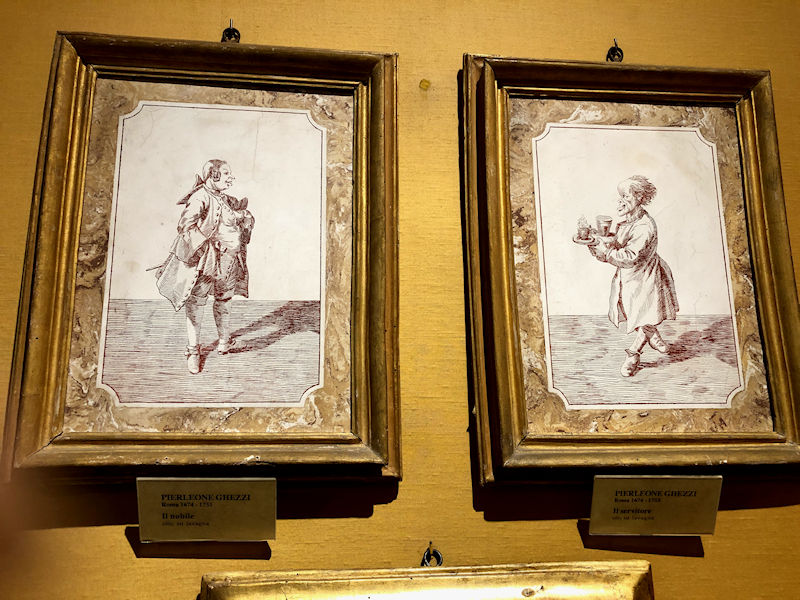
Pierleone Ghezzi (Rome, 1674-1755): 'The Nobleman' [and] 'The Servant'. A famous caricaturist, known for example for the 'Monk with a Carrot and a Woman with a Chamber Pot'.

'The Shepherd Boy', who gave this room its name, by Raffaele Beliazzi (1835-1917). This is here labeled 'Il riposo del Pastorello', so perhaps it's the 'Riposo del pastore' by him that Wikipedia notes was appreciated at the 1877 Exposition of Naples.

This, the 'Capture of Jesus', is a dreadful photo but it's a copy of a picture by Guercino, so we can't just slide past it unnoticed.

An entire roomful of thousands of stringed instruments, well . . .

. . . lots of them anyway. Weird ones, too. This was a vast collection donated to the City Council in 1967 by the physicist Joachim Pasqualini (who studied with Fermi), who was also a musician and instrument maker.
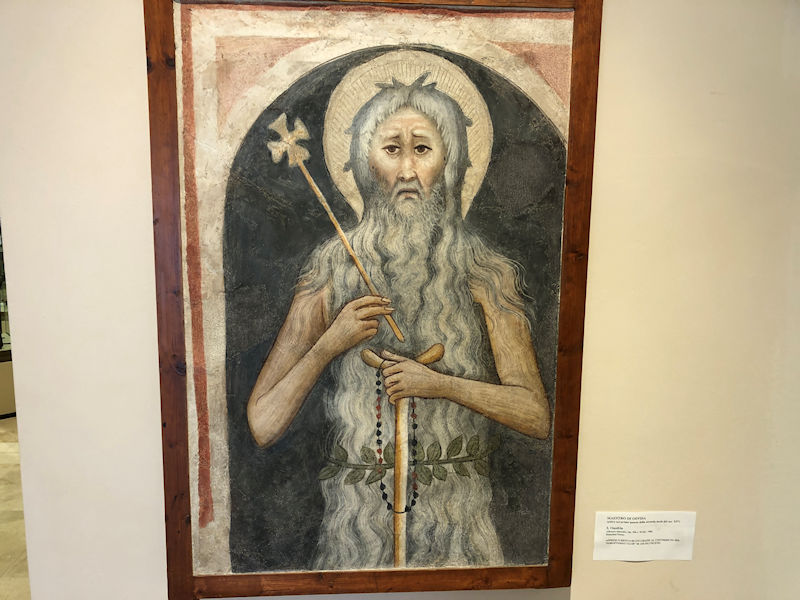
Don't we all know the feeling? Meet S. Onofrio, a detached fresco by the 'Maestro di Offido', active in the mid-14th century (we're visiting Offido tomorrow, we'll look him up). The fresco was restored with funds from the 'Soroptimist Club' of Ascoli Piceno.

This is a representation of Cecco d'Ascoli (née Francesco degli Stabili, aka Cecco de Esculo), a mathematician, philosopher, astrologer, and man of letters who was born in or near Ascoli in about 1269 -- a professor at the University of Bologna, he wrote prolifically, most of it unpublished, but the rest of which was very antagonistic to Church doctrine. Eventually, he was burnt at the stake in Florence by the Inquisition in 1327. There is a large statue as a monument to him in a park in Ascoli that we'll visit in the next day or two.
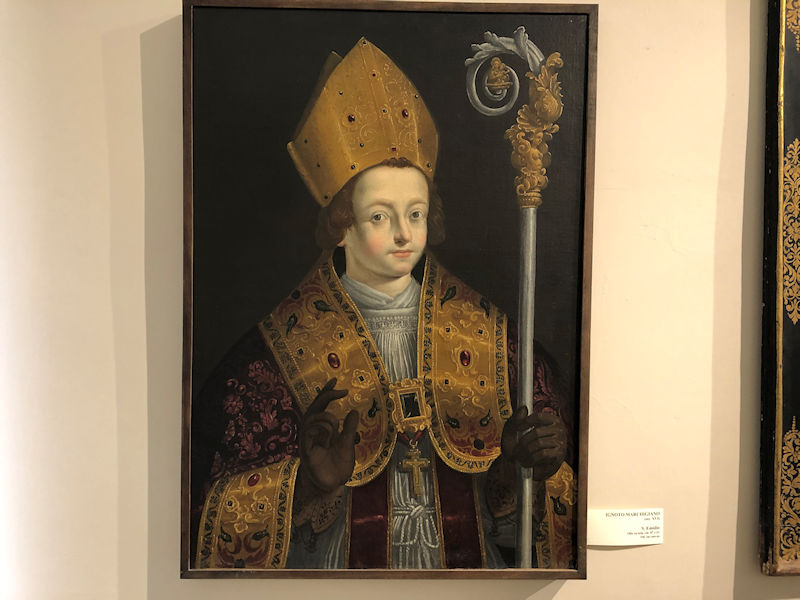
There's that cute little Patron Saint Emidio, hinting at a discreet blessing for us, painted by an Ignoto Marchigiano (who would evidently rather that his name wasn't mentioned).
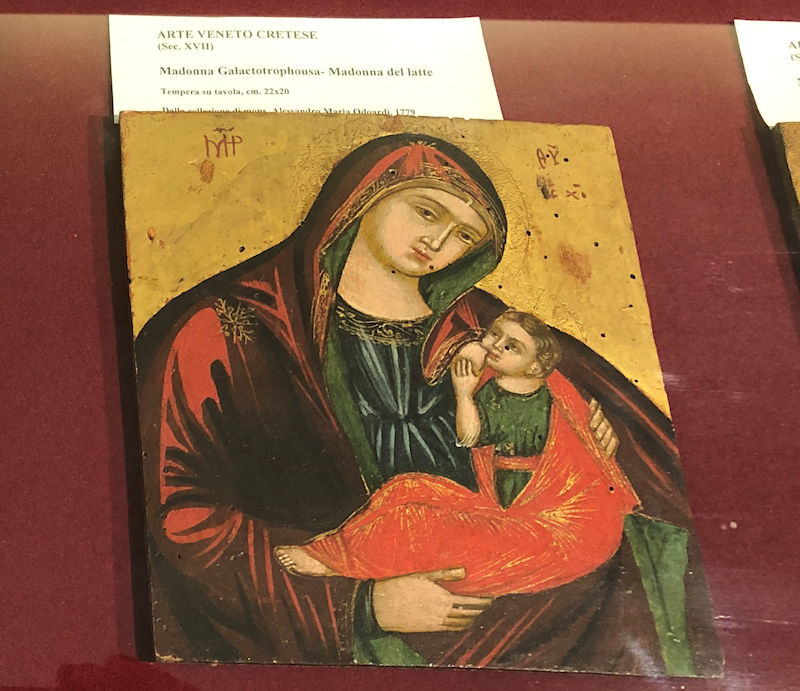
This is a 'Nursing Madonna', credited to an artist from Venetian Crete, tempera on panel and with a sense of anatomy that had largely disappeared by the mid-15th century, but it's oddly dated to the 17th century.
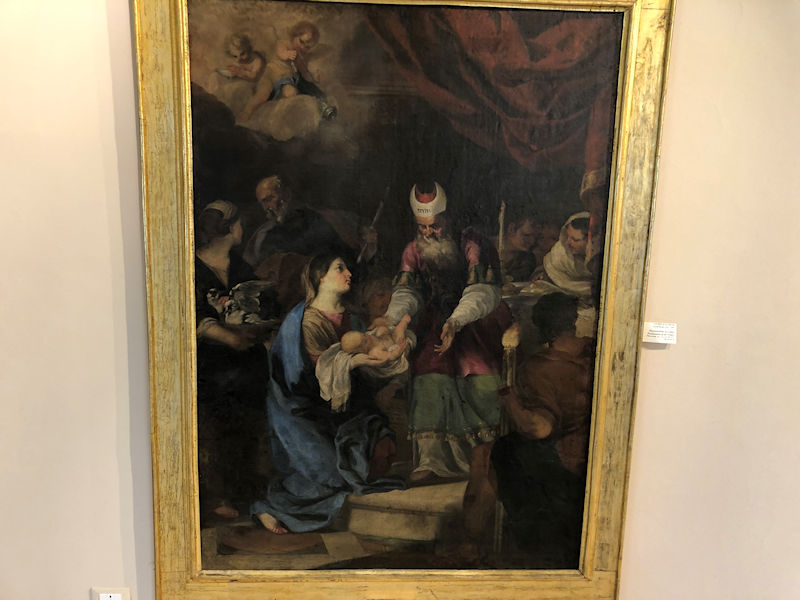
A creditable 'Presentation of Jesus in the Temple' by Ludovico Trasi (1634-1694), a lifelong resident of Ascoli Piceno as a church painter and scenic designer for the theatre.


'The Virgin Mary's education', by another local chap, Nicola Antonio Monti (1736-1795), working in Ascoli Piceno and hereabouts; there appear to be two disembodied young souls in the upper centre and a kid with wings on stealing the other little kid's flower. Wikipedia tells us that 'he died in poverty'.
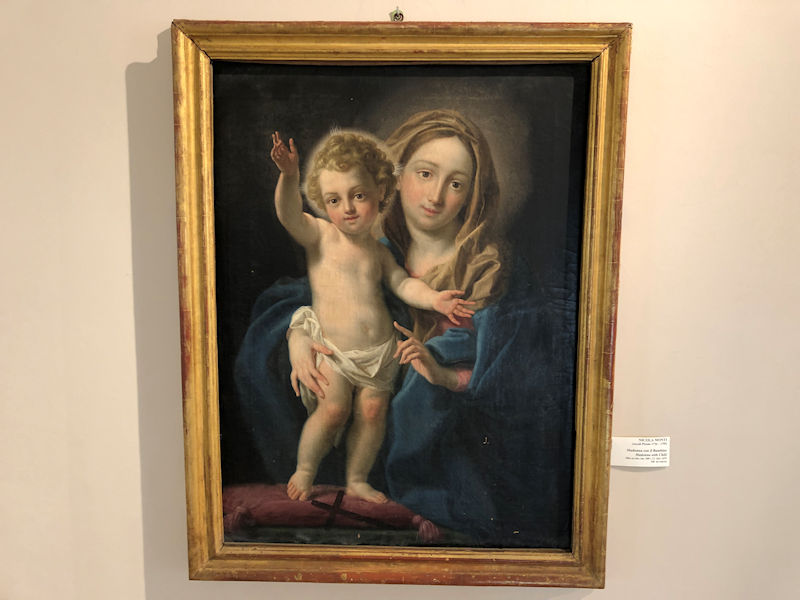
A very cute kid with golden curls, also by Nicola Monti
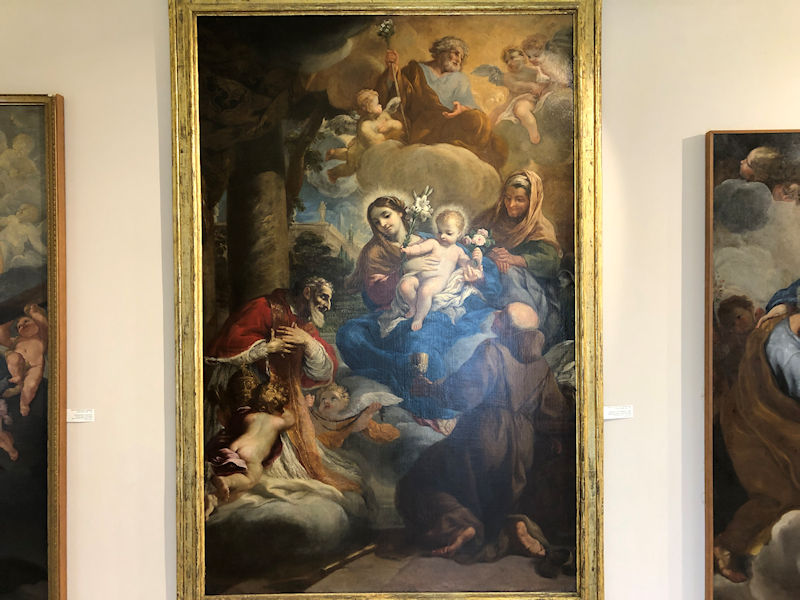
A somewhat overwrought work by Giovan Ventura Borghesi (1604-1708), born in Città di Castello north of Perugia but active for most of his life in Rome: 'the Madonna and Bambino and a bucketload of saints and angels, and maybe that's God up there, too'.
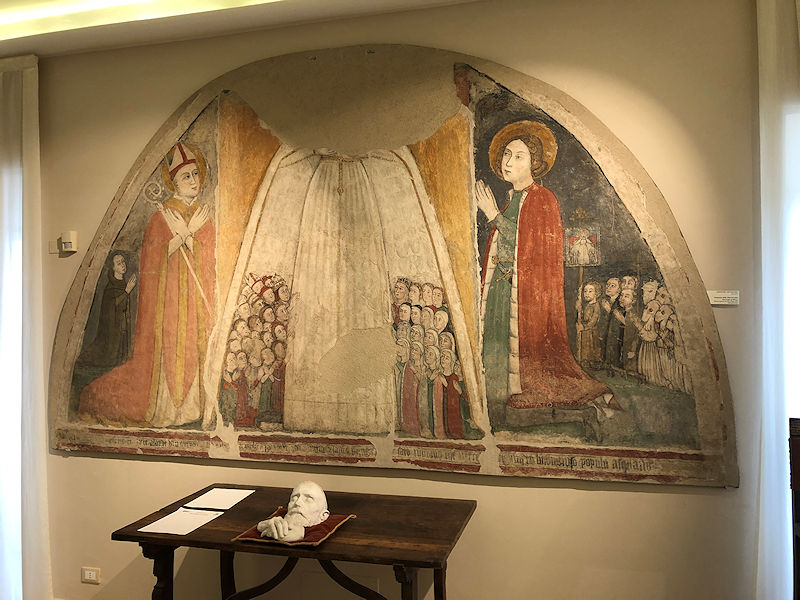
A classic Misericordia, or 'Our Lady of Mercy', but missing the main attraction. By an anonymous Ascolano, 15th century. We note the guys in the lower right with their Ku Klux Klan suits on.
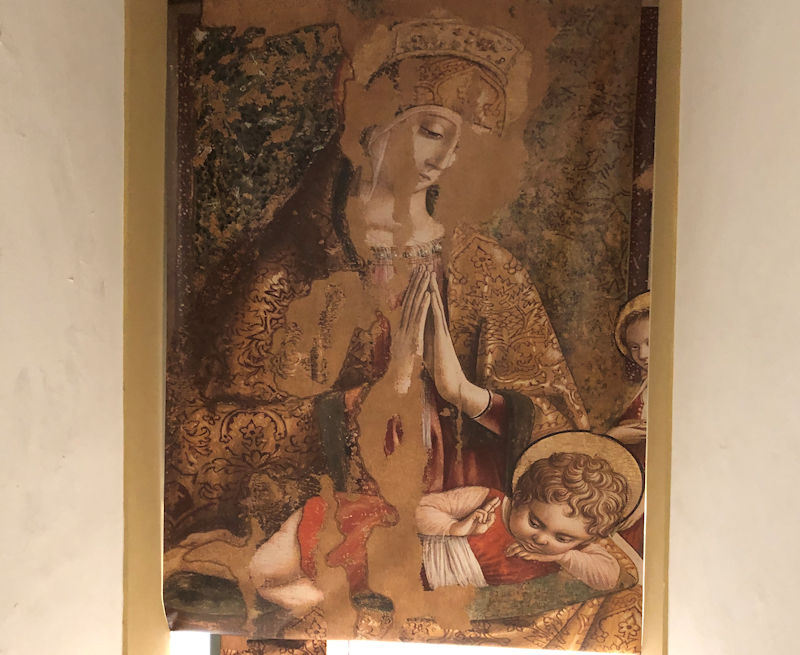
The Baby Jesus who could bless everybody even while he's watching TV.
 Dwight Peck's personal website
Dwight Peck's personal website

















































































